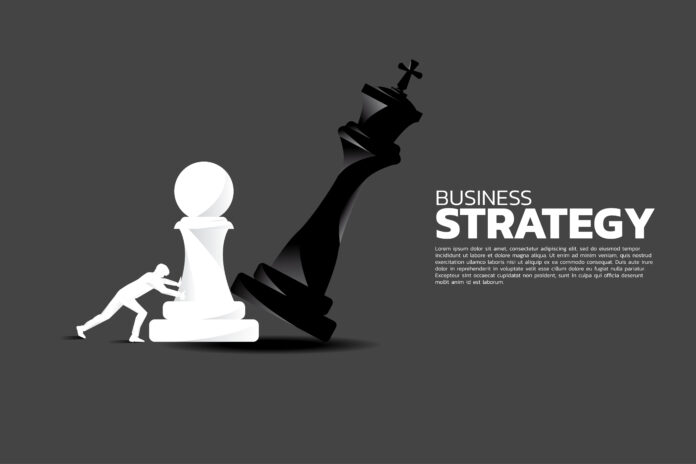How to Stay Ahead of the Game
Why Revolutionizing Your Business Strategy is Crucial in the 21st Century
In today’s fast-paced business world, it is more important than ever to revolutionize your business strategy. With rapid advancements in technology and globalization, companies must be agile and adaptable to remain competitive. Traditional methods of doing business are no longer enough to stay ahead of the curve.
Companies must embrace change and take calculated risks to ensure growth and profitability. Revolutionizing your business strategy means taking a holistic approach to rethinking how you operate.
It involves identifying weaknesses in your current processes, exploring new technologies, expanding into new markets, and building stronger relationships with customers. In this article, we will explore why revolutionizing your business strategy is crucial in the 21st century.
We’ll discuss the ways technology has changed the landscape of modern enterprise, why traditional approaches are no longer effective for growth or success, and what steps you can take to stay ahead of the curve. Buckle up – it’s time for a revolutionary ride!
The Current Business Landscape
The way businesses operate has undergone a dramatic shift in the 21st century due to the combined forces of globalization and technology. Thanks to technology, businesses can now operate in ways that were not possible just a few decades ago. Additionally, changes in consumer behavior have forced companies to adapt their strategies to stay relevant.
Impact of Globalization
Globalization refers to the process by which businesses and economies have become more interconnected on a global scale. It has opened up new markets for businesses and increased competition simultaneously. This has led to companies seeking new ways of doing things in order to maintain their competitive edge.
One effect of globalization is that it has driven down prices as companies seek out cheaper labor markets overseas. This means that many businesses need to find other ways of remaining competitive besides price alone.
Impact of Technology
Technology has revolutionized the way businesses operate, particularly with regards to communication and data management. The rise of mobile devices and social media platforms like Facebook, Twitter, Instagram and LinkedIn provide an easy way for companies to engage with customers on a personal level. Moreover, cloud computing allows companies access data from anywhere at any time while automation tools reduce manual workload allowing staff members focus on more complex tasks.
Impact of Social Media and Big Data
Social media platforms have given rise to an era of customer empowerment where customers can influence brand reputation through online reviews or social sharing. Similarly, big data analysis allows brands identify customer trends enabling them create targeted campaigns with high conversion rates.
Thanks largely in part social media analytics tool which provides insights into your audience’s demographics as well as interests allowing you better tailor your messaging strategy. On the other hand big data analytics help uncover hidden patterns enabling you identify opportunities for growth or areas that need readjustment.
Overall, understanding today’s business landscape means being aware of how technology and globalization have changed the way businesses operate. Companies must stay up to date with these changes in order to remain competitive in a rapidly changing market.
Identifying Your Target Market
In order to revolutionize your business strategy, you must first understand who your target audience is. Conducting market research is the key to identifying this audience. This means gathering data and analyzing trends to determine who your ideal customer is.
There are many ways to conduct market research, but some of the most effective methods include surveys, focus groups, and online analytics. Surveys can be sent out via email or social media to gather information on customer preferences and behaviors.
Focus groups can be arranged in person or online to get more in-depth feedback from a select group of people. Online analytics tools can provide insights into website traffic, social media engagement, and other important metrics that help you understand your audience better.
How to conduct market research
When conducting market research, it’s important to have a clear understanding of what information you’re trying to gather. Start by defining your goals and objectives for the research. What specific questions are you trying to answer?
What data do you need in order to make informed decisions about your business strategy? Once you have a clear idea of what you want to accomplish, it’s time to start gathering data.
This could involve conducting surveys or focus groups with current customers or potential customers who fit within your target demographic. It could also involve analyzing existing data sources such as industry reports or public databases.
Tips for creating buyer personas
One effective way of understanding your target audience is by creating buyer personas. These are fictional representations of your ideal customer that help you better understand their needs, wants, and behaviors. To create a buyer persona, start by gathering information about your target demographic through market research as described above.
Use this data to identify common traits among different segments of your audience (e.g., age range, income level, location). From there, develop a detailed profile for each segment that includes information such as their job title, hobbies, goals, and pain points.
By creating buyer personas and understanding the needs and behaviors of your target audience, you can tailor your marketing messages and product offerings to better meet their needs. This will ultimately lead to a more successful business strategy.
Developing a Unique Value Proposition
Explanation of what a unique value proposition is and why it’s important
A unique value proposition, or UVP, is a statement that describes the unique benefit your business or product offers to customers. It is a way to differentiate yourself from competitors and help customers understand why they should choose your business over others. The UVP should be clear, concise, and easy to understand.
Having a strong UVP is incredibly important in today’s crowded marketplace. With so many similar businesses competing for the same customers, it can be difficult to stand out.
A well-crafted UVP can help you cut through the noise and grab the attention of potential customers. It can also help you build customer loyalty by clearly communicating the benefits of your product or service.
Steps for creating a compelling value proposition that sets your business apart
Creating a compelling UVP takes time and effort, but it’s worth it in order to set your business apart from competitors. Here are some steps to follow:
1. Identify what makes you unique: Start by taking an honest look at your business and identifying what sets you apart from competitors. Do you offer faster delivery times?
Better customer service? A more eco-friendly product?
Whatever it may be, make sure it’s something that matters to your target audience. 2. Focus on benefits rather than features: Your UVP should emphasize the benefits of your product or service rather than just its features.
For example, instead of saying “Our software has 50 different features,” focus on how those features will benefit the user – “Our software saves you hours of time by automating tedious tasks.” 3. Keep it simple: Your UVP should be easy for customers to understand and remember.
Use clear language and avoid industry jargon or buzzwords that may confuse people. 4. Test and refine: Once you’ve created a UVP, test it out on real customers and get their feedback.
Use that feedback to refine your UVP until it’s as compelling and effective as possible. By following these steps, you can create a strong UVP that sets your business apart from others and helps you attract and retain customers.
Leveraging Technology for Business Growth
Automation Tools: Streamlining Your Processes
In today’s fast-paced business world, efficiency is key. One way to boost efficiency and productivity is by leveraging automation tools. Automation tools can help streamline processes, reduce errors, and save time and money.
For instance, if you have a large volume of customer inquiries that need to be addressed regularly, you could set up an AI-powered chatbot to automatically respond to common questions. This will free up your staff’s time so that they can focus on more critical tasks.
Other popular automation tools include marketing automation software that helps schedule social media posts or email campaigns in advance, project management software that allows multiple teams to collaborate on projects in real-time, or even accounting software which can automate invoicing and payment processing. When selecting an automation tool for your business needs, consider factors such as ease of use, scalability, customizability and cost-effectiveness.
Cloud Computing: Improving Accessibility and Scalability
Cloud computing is another powerful technology solution businesses can leverage for growth. With cloud computing services like Amazon Web Services (AWS) or Microsoft Azure, businesses no longer need to invest heavily in their own IT infrastructure because they can access all the necessary resources in the cloud such as servers for storing data or running applications. Cloud computing also offers greater flexibility when it comes to scaling up or down depending on business needs.
For example, if you have an online store that experiences increased traffic during holiday sales periods or promotions due to sudden spikes in demand – with cloud computing – you can quickly adjust your server capacity without having to worry about hardware limitations. When considering a cloud service provider for your business needs ensure that the provider offers high availability guarantees (uptimes), has a strong security track record with proper compliance certifications (such as PCI DSS), and offers flexible pricing options based on usage.
Choosing the Right Technology Solutions for Your Business Needs
When it comes to selecting technology solutions, it’s important to remember that one size does not fit all. The best approach is to identify your business needs and goals, then research and evaluate different technology solutions that will help you achieve those goals.
Consider factors such as cost-effectiveness, ease of use, customization options, scalability, security and support when choosing between different technologies. Some businesses might need a combination of automation tools and cloud services while others might focus solely on social media or email marketing automation.
Keep in mind that technology is always evolving so it’s important to stay up-to-date by attending industry conferences or reading industry publications. : leverage technology to your advantage but make sure you choose the right tools for your business needs.
Creating a Strong Online Presence
In today’s digital era, having a strong online presence is crucial for any business looking to revolutionize their strategies. A well-crafted website with engaging content and an intuitive user interface can attract potential customers and build trust in your brand.
Your website should be optimized for search engines, so that it appears at the top of relevant search results. You can achieve this by creating informative blog posts with targeted keywords and meta descriptions.
Social media platforms like Facebook, Twitter, LinkedIn, and Instagram offer businesses a unique opportunity to connect with customers on a personal level. By sharing interesting content related to your industry, responding timely to comments and messages, you can create an engaged community around your brand.
It’s vital to remember that social media is not just about promoting your products or services; it’s also about building relationships with your customers. Email marketing campaigns still remain one of the most effective ways to connect with potential customers directly.
By offering valuable content in exchange for email addresses, you can create a list of subscribers who are interested in what you have to offer. Sending out regular newsletters with exclusive offers or informative articles keeps this list engaged and helps build loyalty towards your brand.
The Importance of Having an Online Presence
Having an online presence has never been more important than it is today. With most people spending hours every day on their smartphones, tablets or computers browsing the internet means that businesses must have some form of online presence in order to engage potential customers wherever they may be located.
Many people will go straight to Google when they need information about something – whether it’s a product or service they’re interested in buying – which is why having a good website that ranks highly in search results is essential if you want your business to succeed. Online shopping has become increasingly popular as well as necessary since the pandemic hit us last year.
In 2020 alone global retail e-commerce sales reached $4.2 trillion, with projections indicating that this number will rise to $6.5 trillion by 2023. This means businesses without an online store presence are at risk of losing out on a lot of potential revenue.
Strategies for Building an Effective Online Presence
Building an effective online presence requires more than just having a website and social media accounts. You need to have a solid strategy in place that aligns with your business goals and target audience. Firstly, you will want to identify the platforms your target audience frequents most often and set up accounts on those platforms.
By creating unique content tailored to each platform, you can increase engagement and grow your following. Secondly, it’s essential to regularly update your website with fresh content that is optimized for search engines.
This will help you rank higher in search results, which means more visibility for your brand. Thirdly, email marketing campaigns can be incredibly powerful when done correctly.
It’s important to create clear calls-to-action in each email, such as offering exclusive discounts or invites only available through email subscribers. Using analytics tools like Google Analytics can help you track the effectiveness of your online presence strategies so that you can make informed decisions about what works best for your business needs.
Building Strong Relationships with Customers
Why Customer Relationships are Crucial to Long-Term Success
Building strong relationships with customers is essential for any business that wants to succeed in the long term. When you have loyal customers who trust your brand, they’re more likely to make repeat purchases and recommend your business to others. This can help you grow your customer base and increase revenue over time.
In addition, happy customers are more likely to leave positive reviews, which can improve your online reputation and make it easier for potential customers to find your business. On the other hand, if you have a reputation for poor customer service or low-quality products, it could drive potential customers away.
Tips for Building Strong Relationships with Customers through Personalized Communication and Exceptional Customer Service
Personalized communication is key to building strong relationships with customers. People want to feel valued and heard by the brands they interact with. One way to achieve this is by collecting data on customer preferences and behavior so that you can tailor your messaging accordingly.
For example, if you know that a particular customer frequently buys coffee from your shop on their way to work in the morning, you could send them an email promoting a new breakfast item or offer them a discount on their next coffee purchase. Exceptional customer service is also crucial for building strong relationships with customers.
When people reach out to your business with questions or concerns, they want prompt and helpful responses. Make sure that all of your customer-facing employees are trained on how to handle common issues and provide excellent service.
Another way to improve customer service is by proactively reaching out to customers before they have a problem. For example, if someone has recently purchased a product from your online store, you could send them an email checking in on their experience and providing contact information in case they need assistance.
Building strong relationships with customers takes time and effort, but it’s well worth it for the long-term success of your business. By focusing on personalized communication and exceptional customer service, you can create a loyal customer base that will help your business thrive in the years to come.
Conclusion
Revolutionizing your business strategy in the 21st century is not an easy task, but it’s a necessary one. The world is changing rapidly, and businesses must keep up if they want to survive. From understanding the current business landscape to building strong relationships with customers, there are many steps involved in transforming your business strategy.
However, with the right approach and mindset, it’s possible to achieve success. One of the most important takeaways from this article is that businesses must be willing to embrace change.
This means being open-minded about new ideas and technologies that can help transform your operations. It also means being willing to adapt your approach as needed based on feedback from customers and other stakeholders.
Another key takeaway is that customer relationships are more important than ever. In today’s digital age, customers have more power than ever before, and they expect personalized communication and exceptional service.
By focusing on building strong relationships with your customers, you can create a loyal following that will help drive long-term success for your business. It’s worth noting that while revolutionizing your business strategy may seem daunting at first, it’s also an exciting opportunity for growth and innovation.
By taking a proactive approach to change and embracing new ideas and technologies, you can position yourself as a leader in your industry and stay ahead of the curve for years to come. So don’t be afraid to take risks and try new things – the rewards could be greater than you ever imagined!



